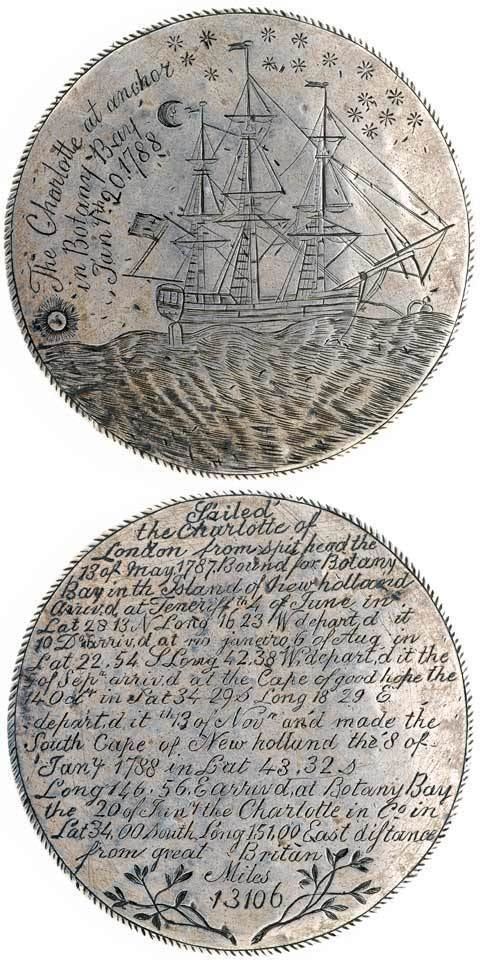 | ||
The Charlotte Medal is a silver medallion 74 millimetres (2.9 in) wide, depicting the voyage of the Charlotte, with the First Fleet, to Botany Bay, Australia. Its obverse depicts a scene of the ship and its reverse is inscribed with a description of the journey. The medal is said to be the first work of Australian colonial art.
Contents
Creation
During the journey the Charlotte visited Rio de Janeiro. Whilst at anchor, one of the ship's convicts, a forger and mutineer by the name of Thomas Barrett was caught giving locals fake coins made from buckles, buttons and spoons. The Surgeon-general of the Fleet, John White was impressed with his skill in making these forgeries, without having the apparent means to do so. This led him to commission Barrett to make the medal, to commemorate the journey, possibly from the surgeon's silver kidney dish. It is created in the style of a Touch piece.
Inscriptions
The obverse of the medal depicts the Charlotte at anchor at night in Botany Bay. The inscription reads
The Charlotte at anchor in Botany Bay Jan'y th.20.1788
The reverse of the medal is inscribed with a journal of the voyage. It reads
Sailed the Charlotte of London from Spit head the 13 of May 1787. Bound for Botany Bay in th Island of new holland arriv,d at Teneriff th4 of June in Lat 28 13 N Long 16 23 W depart,d it 10 D', arriv,d at rio janeiro 6 of Aug in Lat 22,54 S Long 42,38 W, depart,d it the 5 of Sep' arriv,d at the Cape of good hope the 14 Oct' in Lat 34 29 S Long 18 29 E depart,d it th13 of Nov' and made the South Cape of New Holland the 8 of Jan 4 1788 in Lat 43,32 S Long 146,56 E arrivd at Botany Bay the 20 of Jun' the Charlotte in Co in Lat 34.00 South Long 151.00 East distance from great Britan Miles 13106
Owners and ANMM purchase
It is unknown who owned the medal after White. It is possible that he presented it with his voyage findings, or it stayed with his family after his death, but at some point before 1919 it came into the possession of Princess Victoria and Prince Louis.
In 1919 it was sold via Sotheby, Wilkinson & Hodge to a British numismatist, Henry Baldwin.
In 1967 it was sold to an American numismatist, John J Ford.
In 1981 it was sold to a Melbourne dentist, Dr John Chapman, for $15,000 at Spink Sydney Auction. Dr Chapman donated a medal containing a reproduction of the Charlotte Medal to Museum Victoria to mark its bicentennial, in 1988.
In 2008 the Australian National Maritime Museum, with funds from the National Cultural Heritage Account, authorised through the Australian Government, won an auction for the medal with a bid of $750,000. The final price was $873,750, with $200,000 of NCH funding
This makes it possible that, despite its age, the medal has only been sold four times.
Copper medal
A smaller copper medallion, with a diameter of 47 millimetres (1.9 in), was created at the same time. The medal was made for White's personal servant, William Broughton and omits the ship scene, being inscribed simply with an abridged version of the journey. The medallion was uncovered during house restoration in the early 1940s. It has been suggested that this medal should "rank as equal in rarity and significance" as its silver counterpart.
